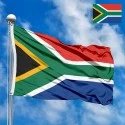The national flag of South Africa is a vibrant and exceptionally symbolic emblem, renowned worldwide for its unique design and the profound message it conveys. Adopted on April 27, 1994, it stands as a powerful testament to the nation's transition from apartheid to a democratic, multicultural society, embodying unity in diversity. This comprehensive exploration delves into the intricate design, the rich symbolism embedded in its colors, its pivotal historical context, its place within the country and the African continent, and its immense significance for all South Africans.
Design and Dimensions
The flag of South Africa is one of the most distinctive national flags in the world, characterized by a unique "Y" or "V" shape that converges from the hoist towards the center. Its design cleverly integrates six different colors, each carefully chosen to represent the nation's journey and aspirations.
-
Dimensions: The standard proportions for the flag are typically 2:3 (height to width), ensuring a balanced and universally recognizable display.
-
Color Arrangement and Elements:
-
The flag features a central green band that splits into a horizontal "Y" shape from the hoist, stretching towards the fly.
-
The two arms of the "Y" are bordered by thin white stripes.
-
Above the "Y" shape, the upper field of the flag is red.
-
Below the "Y" shape, the lower field of the flag is blue.
-
The "Y" shape itself, where it converges at the hoist, forms a large black triangle, bordered by thin gold (or yellow) stripes where it meets the white.
This intricate arrangement creates a dynamic visual representation of convergence and forward movement.
Symbolism of the Colors and Elements
The colors and arrangement on the South African flag were specifically chosen to represent a new, inclusive nation, reflecting historical continuity while embracing a future of unity. The designer, Frederick Brownell, emphasized that no single meaning should be attached to each color, but rather that the flag as a whole represents the convergence of different elements and paths to a unified future. However, popular interpretations of the colors are widely accepted:
-
Black: Primarily represents the black African majority of South Africa, symbolizing their identity, struggles, and the sacrifices made for freedom. It also signifies the power and resilience of the nation's people.
-
Gold (Yellow): This color often symbolizes the natural wealth of South Africa, particularly its mineral resources like gold, which played a significant role in its history. It also represents the future prosperity and the aspirations for economic development for all citizens.
-
Green: Green represents the fertility of the land and the country's natural beauty. It signifies the agricultural richness and the hope for environmental sustainability, crucial for the nation's well-being.
-
White: The thin white stripes bordering the green "Y" represent peace and reconciliation. Historically, white was associated with the European population, but its placement here emphasizes the need for unity and the bridging of divides between different racial groups. It signifies the peaceful coming together of diverse elements.
-
Red (Chilli Red): The red color (officially described as "Chilli Red," a vibrant shade) symbolizes the blood shed during the nation's conflicts and struggles, particularly during the apartheid era. It also represents the courage and dynamism of the South African people.
-
Blue: The blue color represents the skies and the two oceans that border South Africa (the Atlantic and Indian Oceans). It symbolizes opportunity, openness, and truth, reflecting the vastness and potential that lie ahead for the nation.
The "Y" shape itself is the most powerful symbolic element. It represents the convergence of diverse elements within South African society, coming together from different historical paths to move forward in unity. It signifies the path to reconciliation and the collective journey towards a common future.
History of Creation and Adoption
The creation and adoption of the South African flag are inextricably linked to the end of apartheid and the establishment of a democratic South Africa. It was a momentous event, symbolizing a fundamental break from the past and the birth of a new nation.
-
Historical Context: For much of the 20th century, South Africa operated under the system of apartheid, a brutal institutionalized racial segregation. The previous flag, adopted in 1928, was based on the "Prince's Flag" of the Netherlands, incorporating miniature flags of the British Union Jack and the Orange Free State/Transvaal. This flag became heavily associated with apartheid and white minority rule.
-
The Transition: As negotiations for a democratic South Africa gained momentum in the early 1990s, a new national symbol became essential. A competition was held, but none of the thousands of submissions were deemed suitable.
-
Frederick Brownell's Design: In a remarkable turn of events, a new design was quickly created by Frederick Brownell, then the State Herald of South Africa. His design was approved by the Transitional Executive Council and, critically, by Nelson Mandela himself, just days before the first democratic elections.
-
Adoption Date: The current flag was officially adopted on April 27, 1994, the very day of South Africa's first multi-racial democratic elections, which saw Nelson Mandela elected as president. It was initially intended to be an interim flag but was so overwhelmingly embraced by the public that it was formally enshrined in the new Constitution. This swift adoption under immense pressure, yet with such profound public acceptance, underscores its immediate resonance with the nation's aspirations for change and unity.
Country, Region, and Acceptance
South Africa is located at the southernmost tip of the African continent, bordered by the Atlantic and Indian Oceans. It is a diverse country in terms of geography, climate, and culture, often referred to as a "rainbow nation" due to its multicultural population. It is a key member of the Southern African Development Community (SADC) and the African Union (AU).
The flag is the official national flag of the Republic of South Africa and enjoys universal acceptance and immense popularity among all segments of the population. It is proudly displayed at government buildings, schools, sporting events, and by individuals across the country. Its design has become a powerful unifying symbol, transcending historical divisions and fostering a sense of shared nationhood.
Significance for the Inhabitants
For the people of South Africa, the flag holds profound and deeply personal significance:
-
Symbol of New Democracy: It is the most visible and potent symbol of post-apartheid South Africa, representing the triumph of democracy, equality, and human rights after decades of oppression.
-
Unity in Diversity: The flag perfectly embodies the concept of the "Rainbow Nation", signifying the coming together of people from all racial, ethnic, and cultural backgrounds to build a single, unified country. The convergence of the "Y" shape visually reinforces this message of unity.
-
Reconciliation and Hope: It serves as a constant reminder of the nation's journey of reconciliation and healing. Its adoption marked a pivotal moment of hope and a commitment to overcoming past injustices.
-
National Pride: South Africans from all walks of life display immense national pride in their flag, particularly during major events like sporting competitions (Rugby World Cup, FIFA World Cup, Olympic Games), where it is waved with fervor and joy.
-
Shared Future: The flag encourages a sense of shared destiny and collective responsibility for building a prosperous and equitable future for all citizens. It represents the ongoing commitment to the ideals of the new South Africa.
Interesting Facts
-
One of the Newest Flags: The South African flag is one of the newest national flags in the world, having been adopted just over 30 years ago.
-
Designed in a Week: The design process for the current flag was remarkably fast. Frederick Brownell reportedly created it in just one week, under immense pressure to have a new symbol ready for the 1994 elections.
-
Temporary Becomes Permanent: It was originally intended to be a temporary flag for five years, but its overwhelming popularity and symbolic resonance led to its formal adoption as the permanent national flag.
-
Unique Design: Its "Y" shape is a highly unique feature among national flags, making it instantly recognizable globally.
-
No Official Symbolism per Color: While popular interpretations exist, the South African government officially states that no specific symbolism should be attached to individual colors. Instead, the flag's overall design represents the convergence of diverse elements and the path to unity.
-
"Rainbow Nation" Origin: The term "Rainbow Nation" was coined by Archbishop Desmond Tutu to describe post-apartheid South Africa's multicultural diversity and unity, a concept strongly mirrored by the flag's design.
-
Used in Space: The South African flag was taken into space by astronaut Mark Shuttleworth on his mission to the International Space Station in 2002.
-
Distinct Shade of Red: The red used on the flag is officially "Chilli Red," which is a distinct and vibrant shade, not just a generic red.
-
One of the Few Flags with Six Colors: It is one of a very small number of national flags worldwide that prominently feature six distinct colors.
-
Parliamentary Approval: The final design was approved by the Transitional Executive Council and was unveiled to the public on April 20, 1994, just days before its official adoption.
-
Popularity in Sports: The flag is particularly prominent and cherished during international sporting events, where it acts as a powerful unifying force for South Africans.
-
National Flag Day: While not an official public holiday, April 27th (Freedom Day) is also informally recognized as a day to celebrate the flag, given its adoption on that date.
-
Official Flag Hoisting Regulations: South Africa has very specific regulations and protocols for the hoisting, displaying, and respect for its national flag, reflecting its profound importance.
In the demonstration images, full-size flags are shown with proportions of 2:3, and hand-held flags with proportions of 1:2.






 Waving flag
Waving flag
 Sizes:
Sizes:
 Round flag
Round flag
 Sizes:
Sizes:
 Rectangular flag 2:3
Rectangular flag 2:3
 Sizes:
Sizes: